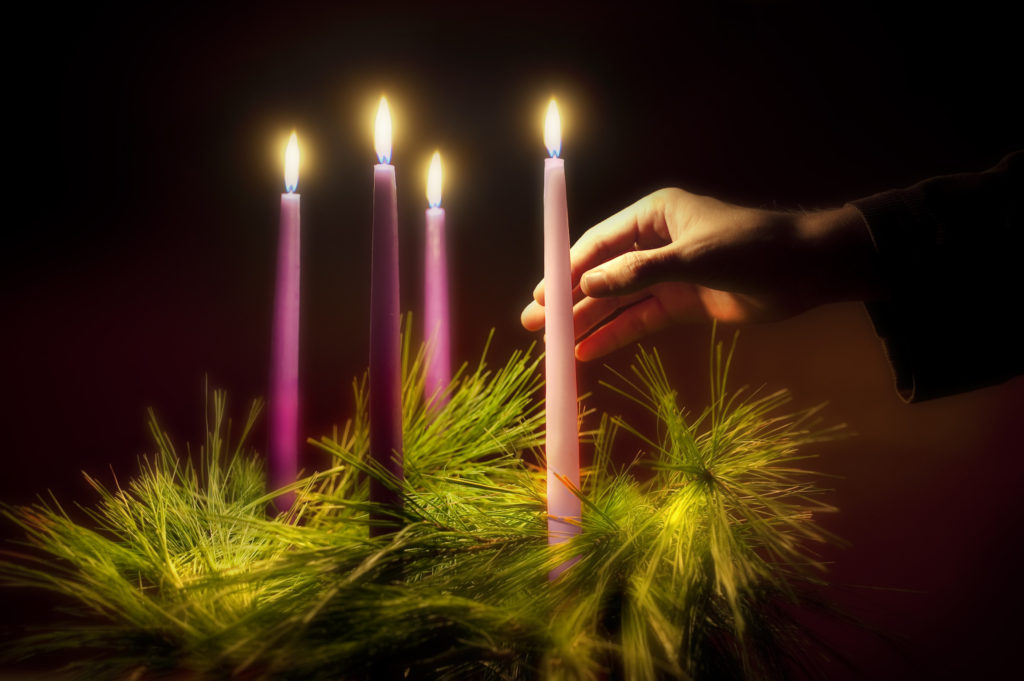

Between the sounds of holiday classics playing on secular radio stations, red coffee cups and “Charlie Brown” specials, it’s easy for Catholics to forget that not only has the Christmas Season not started yet, nor has the season anticipating it, Advent, which begins Sunday, Nov. 29.
Advent, taken from the Latin “advenio,” meaning “to come” anticipates not only the coming of Jesus as a child, but is also to prepare Christians for the Second Coming of Christ. This anticipatory season is filled with its own symbols as well.
“Advent is a kind of schizophrenic season, if you will, because the first half of Advent is all about the end times — it’s all about the coming of Christ in glory, the second coming, final judgment,” said Fr. Kieran Kleczewski, director of the diocese’s Office of Worship. “But as you move through Advent, it becomes much more related to Christ coming” as a child.
One of the most common symbols used in Advent is a wreath, with four candles – three purple and one pink, or rose representing the four Sundays of Advent. The purple, or violet, color represents the penitential nature of Advent.
“Advent is also a season of penance — we don’t think of that, but that’s why the color is violet because it is a season of penacne and preparation,” said Fr. Kleczewski. “Advent is also a recognition of kind of our distance from God, still more a season of anticipation and rejoicing but there’s a penitential nature to it.”
While the emphasis is not as heavy as it is during Lent, Fr. Kleczewski noted that many parishes
The pink – or rose – candle that is lit on the Third Sunday of Advent, is for Gaudete Sunday, which means “rejoice,” because “the Lord is near,” Fr. Kleczewski said.
“We do the same thing at Lent. We go through three quarters of Lent and they do a rose vestment, because it’s meant to say, ‘take courage, it’s almost over,’ and so it’s kind of a joyful celebration,” he said.
To live out the penitential spirit of Advent, Fr. Kleczewski offered several tips. In addition to going to confession during the season, like they do during Lent, Catholics can give something up, take on extra prayer, or perform acts of charity, such as participating in a parish “Angel Tree” program where parishioners buy presents for a child in need.
“It doesn’t have to be to the degree that it is in Lent, but also the whole purpose of the fasting is to try and focus us on what is really important,” he said.
“I think for many of us today the difficulty is we spend so much time getting ready for Christmas doing what? Shopping, buying gifts, worried about the gifts we’re buying, decorating. … In a sense you can get caught up in all the endless Christmas parties and things before Christmas and not really spend much time in terms of personally getting ready to celebrate the Lord’s birth and what that means for us and what it’s meant for the world.”
Advent calendars are a great way to help families understand the season, Fr. Kleczewski said. Some calendars offer a little prize for children each day, while others include a daily meditation for the family.
“If people think about it, I think every family has Advent traditions [though] they may not realize they’re Advent traditions,” he said. “Part of preparing for Christ coming is getting the celebrations ready. I always remember with my mom doing Christmas cookies that were clearly getting made and put away. It was kind of a family thing that we did, but that was part of preparing for Christmas; we always understood it that way.”
Fr. Kleczewski compared the differences between Advent and Christmas like a child waiting for a parent to come home.
“We’re waiting, and we’re waiting, and we’re waiting for them to come home — we can’t wait for them to come home. Well that’s what Advent’s about — it’s about that waiting and building of the longing, again both for the coming kingdom, but also for the celebration of the birth of Christ,” he said.
“Well Christmas is about that kid — the sitting at the window looking outside and seeing his dad walk up the drive who he’d been waiting for for a month and charging into his embrace when he walks through the front door. That’s the Christmas season — it’s about that arrival, that having that joy knowing that Christ is here, we’ve been redeemed and His love is here for us.”





